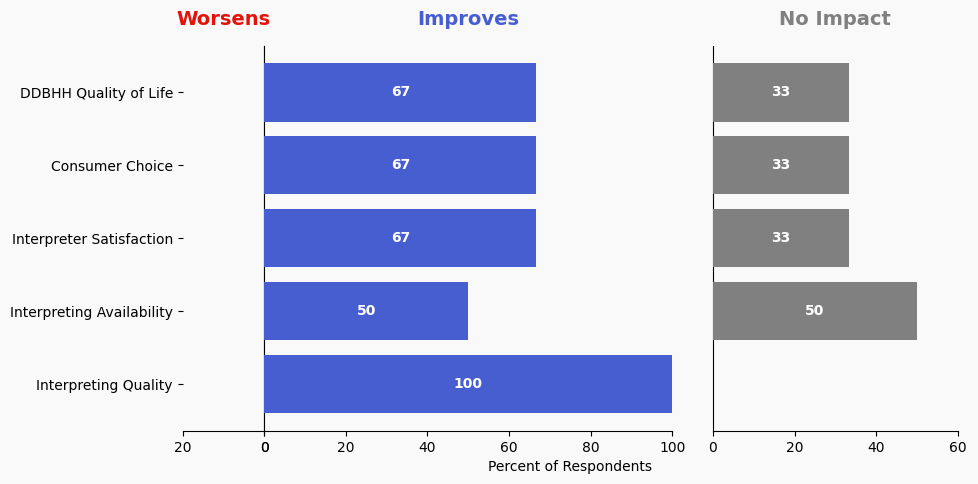84 Provide Legal Interpreting Workshop Series
Issue: Insufficient number of qualified interpreters for legal interpreting.
Proposed Solution: Coalition partner with the Minnesota Judicial Branch Court Interpreter Program to provide a legal interpreter training series for Deaf and hearing interpreters. Legal training series to include introductory through advanced training. They could partner this training series with a BEI Court Certificate scholarship program (See potential solution #100).
Expected outcome: MJB will provide better services for and avoid violation of rights for DDBHH Minnesotans. DDBHH Minnesotans will experience justice more on par with their peers who do not have a hearing loss. A larger number of hearing and Deaf interpreters for the courts will have greater skills for legal interpreting.
Who is impacted: Consumers, court interpreters
Timeline: 6 months

Summary of Support Image Description
The stacked bar charts show how respondents rated their level of support and the total number of responses. The percentage for the five support levels is shown from left to right: Strongly Oppose (Dark Red), Oppose (Light Red), Neutral (Yellow), Support (Light Blue), and Strongly Support (Dark Blue).
Respondents may identify with multiple subgroups. The overall level of support is:
Overall
Strongly Oppose: 1%
Oppose: 0%
Neutral: 12%
Support: 41%
Strongly Support: 46%
Click to see the detailed image description for each subgroup.
Interpreter
Strongly Oppose: 2%
Oppose: 0%
Neutral: 8%
Support: 37%
Strongly Support: 53%
DDBHH Consumer
Strongly Oppose: 0%
Oppose: 0%
Neutral: 13%
Support: 44%
Strongly Support: 44%
System Stakeholder
Strongly Oppose: 0%
Oppose: 0%
Neutral: 13%
Support: 51%
Strongly Support: 36%
Overview of Respondents Opting for In-Depth Solution Analysis
After indicating their support level, 2% of the 111 respondents opted in to further assess whether the solution would worsen or improve on five metrics. Of the opt-in reviewers (3 respondents), 66% supported the solution, 0% were neutral on the solution, and 33% opposed the solution.
The remaining 108 respondents did not opt in to further assess the solution. Of these people, 87% support the solution, 12% were neutral on the solution, and 0% opposed the solution.
Reviewer Evaluation of Solution Effectiveness

Solution Effectiveness Image Description
The stacked bar charts show how respondents assessed the effectiveness of this solution based on five metrics. For each metric, the percentage of respondents is shown from left to right: Worsens (Red), Improves (Blue), No Impact (Gray).
DDBHH Quality of Life
Makes It Worse 0%
Makes It Better 66%
No Impact 33%
Interpreter Satisfaction
Makes It Worse 0%
Makes It Better 66%
No Impact 33%
Consumer Choice
Makes It Worse 0%
Makes It Better 66%
No Impact 33%
Interpreting Availability
Makes It Worse 0%
Makes It Better 50%
No Impact 50%
Interpreting Quality
Makes It Worse 0%
Makes It Better 100%
No Impact 0%
Reviewer Feedback and Insights
Interpreter
One comment from Interpreters suggests that the core issue is not a lack of training but rather a lack of recognition and respect for credentials among legal interpreters. The comment highlights division within the legal interpreting community, noting that credentialed interpreters excluded rostered court interpreters during a recent court interpreter strike. The comment also expresses doubt about the effectiveness of additional court trainings without addressing underlying divisions and calls for mediation before the community can move forward.
Deaf, DeafBlind, Hard of Hearing
No comments were submitted.
System Stakeholder
No comments were submitted.
PREVIOUS SOLUTION
Issue: There are many issues with achieving effective communication access in court settings. Quality issues include: Inconsistency of interpreters assigned Struggle to assign CDIs Working interpreters having no consistent venue for sharing necessary feedback regarding the work conditions
NEXT SOLUTION
Issue: Rule 8 is a policy that requires court scheduling staff to attempt to schedule SC:Ls first. Currently, not all scheduling staff follow Rule 8, thus resulting in any interpreter on the roster or through a subcontracted agency being sent for court proceedings.
Leave a Reply